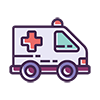0Types of Defibrillators and Their Uses
A defibrillator is a device used to treat sudden cardiac arrest. It gives an electric shock that jolts the heart back to its regular rhythm.
But did you know that there are different types of defibrillators with unique features and uses?
In this article, we will run you through the five major types of defibrillators. While some can be used by laypersons, others require skilled hands to operate them. Some are also implantable and wearable and work automatically in case of cardiac arrest.
5 Types of Defibrillators
From automated external defibrillators to advanced life support defibrillators and manual external defibrillators, take a look at these different devices and their uses.
1. Automated External Defibrillators
AEDs, or automated external defibrillators, are lightweight, portable devices that use electric pulses to treat sudden cardiac arrest. Once strapped on, the device detects irregular heart rhythms. If needed, it delivers an electric shock to restore the normal heart rhythm.
AEDs are designed for use by individuals with minimal training in life support. They are widely available in airports, schools, gyms, offices, malls, and other public places.
In case of a sudden cardiac arrest, AEDs can increase the chance of survival by 49% to 75%. That’s because bystanders can step in to save the victim before emergency responders arrive at the scene.
2. Advanced Life Support Defibrillators
 Advanced life support defibrillators (ALS) are used by healthcare experts in hospitals and ambulances. These are heavy-duty machines that monitor the patient’s heart rhythm. In case of an irregularity, manual intervention is required to deliver an electric shock.
Advanced life support defibrillators (ALS) are used by healthcare experts in hospitals and ambulances. These are heavy-duty machines that monitor the patient’s heart rhythm. In case of an irregularity, manual intervention is required to deliver an electric shock.
In addition, ALS defibrillators use advanced algorithms to make shock suggestions. They also monitor the victim’s carbon monoxide levels, blood pressure, temperature, and other key medical information.
All these elements help stabilize the victim’s heart rhythm and ensure their heart is pumping blood. This greatly increases their chances of survival.
3. Implantable Cardioverter-Defibrillators
An ICD, or implantable cardioverter-defibrillator, is a small, battery-powered device. It’s an effective treatment for people with a high risk of sudden cardiac arrest. This includes people with a history of cardiac arrest, genetic predisposition to irregular heartbeats, or a congenital heart defect.
ICD is surgically implanted in the patient’s chest. It continuously monitors the heart’s electrical activity and delivers a shock in case of an irregular heartbeat. This increases the survival rate in people with genetically-inherited heart arrhythmia, or irregular heartbeat.
That said, ICDs do carry certain risks. These include the risk of infection, bleeding, and damage to the blood vessels during the implantation surgery.
4. Manual External Defibrillators
 Like ALS defibrillators, manual external defibrillators require healthcare professionals to operate them. Hence, they’re found only in hospitals and some ambulances.
Like ALS defibrillators, manual external defibrillators require healthcare professionals to operate them. Hence, they’re found only in hospitals and some ambulances.
With manual defibrillators, the medical expert will select a specific shock frequency to deliver the shock. And since the dose of the shock can be customized, the device can be used on babies experiencing cardiac arrest.
In addition, manual defibrillators have capabilities that AEDs do not. They can monitor the patient’s oxygen levels, concentration of carbon dioxide, and blood pressure.
Connected to the ECG, this device also offers a more accurate, timely glimpse of the victim’s heart activity than AEDs can.
5. Wearable Defibrillators
A wearable defibrillator, or WCD, is a device that patients can wear under their clothes. It’s non-invasive and consists of a vest, electrode belt, and monitor. It’s recommended for patients who are not candidates for ICD.
WCDs help detect irregular heart rhythms and deliver a shock to restore the wearer’s heartbeat. They are fully automatic and don’t require any user intervention.
In most cases, WCDs are prescribed to patients for short-term risk mitigation. For instance, patients awaiting a heart transplant or ICD replacement might need WCD support in the interim.
The Wrap Up
Each of the five types of defibrillators work in different ways. While AED can be used in public settings by laypersons, ALS and manual external defibrillators need medical experts to operate them.
Similarly, while ICDs need to be surgically implanted in the patient’s chest, wearable defibrillators can simply be worn as vests.
That said, all defibrillators work towards the same goal: to monitor the patient’s heartbeat and deliver a life-saving shock.
